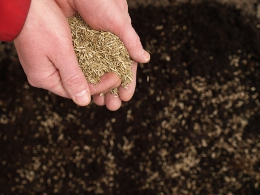 When choosing to install a new lawn, learning how to plant grass seed can be an excellent way to save money and ensure that your grass grows from outstanding, high quality seed stock.
When choosing to install a new lawn, learning how to plant grass seed can be an excellent way to save money and ensure that your grass grows from outstanding, high quality seed stock.
Once you have made the choice to grow your lawn from seed, it will be important to grade and prepare the soil before you plant it. The time and effort involved to improve the soil before you seed it will reduce water usage and improve the health and appearance of your yard for years.
A good soil is well-structured, which allows water to be absorbed deep into the ground and encourage strong grass root formation. Providing plentiful organic matter is the solution to both clay and sandy soils. Organic material provides nutrients and diverse particle sizes, which opens up avenues for water and nutrient retention and creates room for the roots to establish themselves. To properly prepare your soil, do the following:
Prepare your Soil
1. Before planting grass seeds, and after removing any weeds, rototill the top six inches of the soil to add oxygen and break up any compacted areas.
2. Till in organic matter. This can come from compost, black topsoil, shredded leaves or grass clippings, or a slow release, organic matter-based fertilizer.
3. Contact a local county extension agent to determine if any additional soil amendments are recommended.
Install a Sprinkler System
1. After the soil has been improved, install a sprinkler system.
2. Use a rake to level the soil and remove any large rocks.
3. A lawn roller, half filled with water, should be used to firm the soil without overly compacting it.
Plant the New Grass Seeds
1. The best way to plant grass seed is to use a drop spreader to apply the seeds in two different directions. Take one pass and plant half the seed while walking in, say, a east to west direction, and then apply the rest of it in a north to south direction.
2. The amount of seed to be applied depends on which grass species you are planting, so be sure to follow the directions.
3. After applying the seed, use a rake to lightly mix the seed into the soil. A common mistake is to force the seeds too deep – they should only be about 1/4 inch deep.
4. Watering and soil moisture levels will vary by species and time of year you are seeding the grass.


